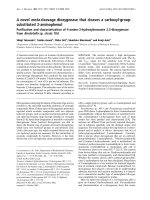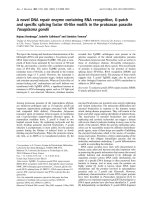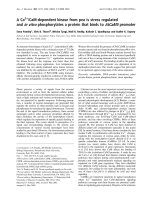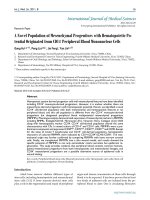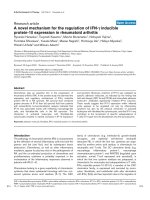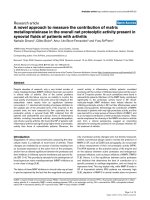Báo cáo y học: " A novel trifunctional IgG-like bispecific antibody to inhibit HIV-1 infection and enhance lysis of HIV by targeting activation of complement" ppsx
Bạn đang xem bản rút gọn của tài liệu. Xem và tải ngay bản đầy đủ của tài liệu tại đây (398.25 KB, 4 trang )
Jia et al. Virology Journal 2010, 7:142
/>Open Access
HYPOTHESIS
© 2010 Jia et al; licensee BioMed Central Ltd. This is an Open Access article distributed under the terms of the Creative Commons Attri-
bution License ( which permits unrestricted use, distribution, and reproduction in any
medium, provided the original work is properly cited.
Hypothesis
A novel trifunctional IgG-like bispecific antibody to
inhibit HIV-1 infection and enhance lysis of HIV by
targeting activation of complement
Leili Jia
†1
, Yuanyong Xu
†1
, Chuanfu Zhang
†1
, Yong Wang
†1
, Huihui Chong
†2
, Shaofu Qiu
†1
, Ligui Wang
1
,
Yanwei Zhong
5
, Weijing Liu
1
, Yansong Sun
1
, Fei Qiao
3
, Stephen Tomlinson
3
, Hongbin Song*
1
, Yusen Zhou*
4
and
Yuxian He*
2
Abstract
Background: The complement system is not only a key component of innate immunity but also provides a first line of
defense against invading pathogens, especially for viral pathogens. Human immunodeficiency virus (HIV), however,
possesses several mechanisms to evade complement-mediated lysis (CoML) and exploit the complement system to
enhance viral infectivity. Responsible for this intrinsic resistance against complement-mediated virolysis are
complement regulatory membrane proteins derived from the host cell that inherently downregulates complement
activation at several stages of the cascade. In addition, HIV is protected from complement-mediated lysis by binding
soluble factor H (fH) through the viral envelope proteins, gp120 and gp41. Whereas inhibition of complement activity is
the desired outcome in the vast majority of therapeutic approaches, there is a broader potential for complement-
mediated inhibition of HIV by complement local stimulation.
Presentation of the hypothesis: Our previous studies have proven that the complement-mediated antibody-
dependent enhancement of HIV infection is mediated by the association of complement receptor type 2 bound to the
C3 fragment and deposited on the surface of HIV virions. Thus, we hypothesize that another new activator of
complement, consisting of two dsFv (against gp120 and against C3d respectively) linked to a complement-activating
human IgG1 Fc domain ((anti-gp120 × anti-C3d)-Fc), can not only target and amplify complement activation on HIV
virions for enhancing the efficiency of HIV lysis, but also reduce the infectivity of HIV through blocking the gp120 and
C3d on the surface of HIV.
Testing the hypothesis: Our hypothesis was tested using cell-free HIV-1 virions cultivated in vitro and assessment of
virus opsonization was performed by incubating appropriate dilutions of virus with medium containing normal human
serum and purified (anti-gp120 × anti-C3d)-Fc proteins. As a control group, viruses were incubated with normal human
serum under the same conditions. Virus neutralization assays were used to estimate the degree of (anti-gp120 × anti-
C3d)-Fc lysis of HIV compared to untreated virus.
Implications of the hypothesis: The targeted complement activator, (anti-gp120 × anti-C3d)-Fc, can be used as a
novel approach to HIV therapy by abrogating the complement-enhanced HIV infection of cells.
* Correspondence: , ,
1
Institute of Disease Control and Prevention, Academy of Military Medical
Science, Beijing 100071, PR China
4
Institute of Pathogen Biology, Chinese Academy of Medical Sciences and
Peking Union Medical College, Beijing 100730, PR China
†
Contributed equally
Full list of author information is available at the end of the article
Jia et al. Virology Journal 2010, 7:142
/>Page 2 of 4
Background
The human immunodeficiency virus (HIV) causes severe
immune deficiency in humans and over 7,000 people are
infected everyday [1]. The key to resistance to HIV infec-
tion and disease progression resides within the host
immune system that consists of two major defense path-
ways: innate and adaptive immunity [2]. There is a grow-
ing recognition that the complement system contributes
to HIV replication and pathogenesis [3,4]. In fact, as a
first line of defense against pathogenic microorganisms
and a mediator between the innate and adaptive immune
responses, the complement system is a particular focus of
these immune-evasion strategies [4-6]. In human plasma,
HIV immediately activates the complement system, even
in the absence of HIV-specific antibodies [7]. After sero-
conversion, the presence of HIV-specific antibodies trig-
gers further activation of the classical complement
pathway [11]. Complement activation would be harmful
to the virus if the reactions were allowed to go to comple-
tion, since their final outcome would be virolysis. HIV,
however, has evolved several mechanisms to evade com-
plement-mediated lysis (CoML) and exploit the comple-
ment system to enhance viral infectivity [8]. This may be
critical, as during opsonization, high amounts of C3-frag-
ments are deposited on the surface of HIV. Also, binding
of C3-fragments to gp120 reduces the accessibility of the
viral envelope protein [9]. Current therapies for HIV
infection using highly active antiretroviral therapy
(HAART) are not able to completely eliminate virus and
complications of these therapies include severe side
effects and viral resistance that may establish latent reser-
voirs of HIV. There remains a need to develop novel
treatments for infected individuals who may no longer
respond to or who have significant toxicity from antiret-
roviral therapy and to prevent HIV transmission [10]. To
this end, bispecific antibody (BsAb) constructs may be
used to target HIV and infected cells for destruction,
resulting in greater control and prevention of infection.
We previously reported a targeted complement activator
[11], CR2-Fc, and the results shown that CR2-Fc can
enhance lysis of HIV (data not show). However, the tar-
gets of CR2-Fc are C3d and C3dg, which can be distrib-
uted widely when complicating other diseases. Thus, it is
interesting to know whether target to HIV envelope could
improve the anti-virus efficacy of complement. Here, we
hypothesize that a bispecific, trifunctional antibody con-
struct incorporating the disulfide-stabilized Fv fragments
(dsFv) against gp120, the dsFv against C3d and Fc pro-
motes destruction of HIV type 1 (HIV-1) by complement.
Presentation of the hypothesis
Intrinsic resistance of HIV against the complement system
As mentioned above, HIV is resistant to lysis by the com-
plement MAC C5b-9 [12-17]. Responsible for this intrin-
sic resistance against complement-mediated virolysis are
complement regulatory membrane proteins derived from
the host cell, which are acquired by HIV during the bud-
ding process [18]. Among them are regulators of comple-
ment activation (RCAs) such as accelerating factor (DAF,
CD55), membrane cofactor protein (MCP, CD46) or
CD59, which within a species (human serum human
cells) down-regulate complement activation at several
stages of the cascade [19-21]. In addition, HIV is pro-
tected from complement-mediated lysis by binding solu-
ble factor H (fH) through gp120 and gp41 [22-24]. The
crucial role of fH for protection of the virus is evident,
since incubation of HIV with fH-depleted sera results in
up to 80% of complement-dependent virolysis in the pres-
ence of HIV-specific antibodies [23]. Similar to fH-
depleted sera that promotes CoML, an fH-derived pep-
tide is able to enhance C3 deposition on HIV infected
cells and thus to induce virolysis. However, without inter-
vention HIV remains resistant to human serum [25]. This
acquired resistance can further promote infection since
fH promoter factor I to cleave activated C3 on the viral
surface into iC3b and C3d [24]. C3d remains covalently
bound to the target [17]. The resultant opsonized virus
thus enhances its infectivity toward CR1, CR2 and CR3-
positive cells [24]. Due to these protection mechanisms,
opsonized HIV accumulates in all complement-enriched
compartments of the host, such as blood, lymphatic tis-
sue (LT), brain, mother's milk, seminal fluid or mucosal
surfaces [17]. Strikingly, gp120 is also responsible for
recruiting the regulators factor CD59 to the surface of the
virus. In addition to inhibition of MAC formation by
CD59, the degradation of C3b by factor I and factor H
reduces amplification. Whereas inhibition of comple-
ment activity is the desired outcome in the vast majority
of therapeutic approaches, its local stimulation may be
beneficial for the lysis of HIV.
Bispecific antibodies considered "trifunctional"
The hallmark of monoclonal antibodies is their specificity
for a particular antigen that enables them to bind their
target precisely in vivo while ignoring antigen-negative
sites. Monoclonal antibodies of the IgG type contain two
identical antigen-binding "arms" and a constant fragment
(Fc). Furthermore, the human IgG1 Fc domain can also
play a role of fixing complement system. Recent findings
have generated renewed interest in so-called "non-neu-
tralizing" antibodies that are unable to directly inhibit
free virus entry into target cells, but nonetheless, exhibit
antiviral activity mediated by the Fc region of the anti-
body molecule. One class of antibody derivatives with the
promise of enhanced potency for the treatment of disease
is bispecific antibodies (BsAbs) that can bind to two dis-
tinct epitopes. Besides the dual-specific antigen binding
fragment (Fab) parts, they contain an Fc portion and can
Jia et al. Virology Journal 2010, 7:142
/>Page 3 of 4
thus be considered 'trifunctional' [26]. Antibodies with a
dual specificity in their binding arms usually do not occur
in nature and, therefore, had to be crafted with the help of
recombinant DNA or cell-fusion technology. These anti-
body effector mechanisms include complement binding
and viral lysis, phagocytosis of antibody-coated virions,
and antibody-dependent cellular cytotoxicity [27,28].
Mark et al [10] reported a bispecific antibody to promote
destruction of HIV-1 by neutrophils. The bispecific anti-
body incorporated the variable regions of the anti-gp41
antibody, F240, and the anti-CD89 antibody, 14A8. How-
ever, relatively little is known about the potential of com-
plement-mediated destruction of HIV through bispecific
antibody.
The hypothesis
The hypothesis presented here investigates a new strat-
egy using a bispecific antibody to target and amplify com-
plement activation on HIV virions regardless of
modulating complement inhibitor expression. The IgG-
like bispecific antibody is constructed through incorpo-
rating the dsFv against gp120 and the dsFv against C3d,
then linking to a complement-activator (human IgG1 Fc
domain). The trifunctional bispecific antibody, (anti-
gp120 × anti-C3d)-Fc, has two different antigen-specific
binding sites, one for HIV gp120 and the other for the
C3d. It is expected not only to target block HIV-gp120
and C3d on the surface of HIV, but also can enhance
complement activation through the complement-activat-
ing Fc domain. Thus, (anti-gp120 × anti-C3d)-Fc can
reduce the infectivity of HIV through blocking gp120 and
C3d on the surface of HIV, since they can bind to their
receptors and help virus to infect cells. Moreover, (anti-
gp120 × anti-C3d)-Fc will inhibit the complement inhibi-
tors (fH and CD59) binding to HIV that may enhance
CoML. More importantly, this targeted complement acti-
vator is able to bind to sites of complement activation, so
it is likely to improve their efficacy while reducing poten-
tially serious side effects resulting from complement acti-
vation. Furthermore, the human IgG1 Fc domain can also
play a role of repairing the complement system. Subse-
quently, the positive feedback loop generated by the com-
plement cascade results in enhanced lysis of HIV and
preventing infection of susceptible cells. Therefore, they
represent a feasible approach against infection if they can
be directed and armed to destroy HIV and infected cells.
Testing of the hypothesis
After preparation of human (anti-gp120 × anti-C3d)-Fc
fusion protein, biodistribution studies were performed to
evaluate the biologic activity of (anti-gp120 × anti-C3d)-
Fc in vitro. HIV-1 was cultivated in H9 cells and cell-free
virus obtained from supernatants. Infection experiments
were performed in 24-well plates in triplicate and virus
opsonization was performed by incubating appropriate
dilutions of HIV in culture medium with normal human
serum (NHS) and purified (anti-gp120 × anti-C3d)-Fc
proteins. A control group included viruses that were
incubated with NHS only under the same conditions.
Finally, neutralization tests were used to estimate the effi-
ciency of (anti-gp120 × anti-C3d)-Fc enhanced lysis of
HIV compared to controls.
Implication of the hypothesis
A successful test of the hypothesis would demonstrate
that (anti-gp120 × anti-C3d)-Fc can bind to HIV virions
and can result in an amplification of the complement
activation cascade. As a consequence of this action, HIV
would likely be eliminated by CoML and further infection
by HIV should be inhibited. Furthermore, (anti-gp120 ×
anti-C3d)-Fc bound to HIV virions is likely to reduce
potential damage of host cells and tissues resulting from
excess complement activation. Thus, it is meaningful to
investigate the potential role of (anti-gp120 × anti-C3d)-
Fc for the abrogation of HIV infection in humans, as this
new finding would suggest another novel approach for
HIV therapy.
Competing interests
The authors declare that they have no competing interests.
Authors' contributions
LLJ, YYX and HBS prepared the manuscript. CFZ, YW, SFQ, LGW, YWZ, WJL, YSS,
FQ, ST, YSZ, YXH participated in developing the hypothesis and collaborated in
writing and reviewing of the article. All authors read and approved the final
manuscript.
Acknowledgements
This work was supported by a grant from the Natural Science Foundation (No.
30801004; No. 30772001; No. 30671927; No. 30900067) and National 863 Proj-
ect (No.2007AA02Z144).
Author Details
1
Institute of Disease Control and Prevention, Academy of Military Medical
Science, Beijing 100071, PR China,
2
Institute of Pathogen Biology, Chinese
Academy of Medical Sciences and Peking Union Medical College, Beijing
100730, PR China,
3
Department of Microbiology and Immunology, Medical
University of South Carolina, Charleston, South Carolina 29425, USA,
4
State Key
Laboratory of Pathogen and Biosecurity, Beijing Institute of Microbiology and
Epidemiology, Beijing 100071, PR China and
5
The 302nd Hospital of People's
Liberation Army, Beijing 100039, PR China
References
1. Piot P, Bartos M, Larson H, Zewdie D, Mane P: Coming to terms with
complexity: a call to action for HIV prevention. Lancet 2008,
372:845-859.
2. Levy JA, Scott I, Mackewicz C: Protection from HIV/AIDS: the importance
of innate immunity. Clin Immunol 2003, 108:167-174.
3. Datta PK, Rappaport J: HIV and complement: hijacking an immune
defense. Biomed Pharmacother 2006, 60:561-568.
4. Stoiber H, Banki Z, Wilflingseder D, Dierich MP: Complement-HIV
interactions during all steps of viral pathogenesis. Vaccine 2008,
26:3046-3054.
5. Walport MJ: Complement. First of two parts. N Engl J Med 2001,
344:1140-1144.
Received: 30 April 2010 Accepted: 29 June 2010
Published: 29 June 2010
This artic le is available fro m: http://www.v irologyj.com/co ntent/7/1/142© 2010 Jia et al; licensee BioMed Central Ltd. This is an Open Access article distributed under the terms of the Creative Commons Attribution License ( which permits unrestricted use, distribution, and reproduction in any medium, provided the original work is properly cited.Virology Journal 2010, 7:142
Jia et al. Virology Journal 2010, 7:142
/>Page 4 of 4
6. Walport MJ: Complement. Second of two parts. N Engl J Med 2001,
344:1158-1166.
7. Stoiber H, Pruenster M, Ammann CG, Dierich MP: Complement-
opsonized HIV: the free rider on its way to infection. Mol Immunol 2005,
42:153-160.
8. Banki Z, Stoiber H, Dierich MP: HIV and human complement: inefficient
virolysis and effective adherence. Immunol Lett 2005, 97:209-214.
9. Pruenster M, Wilflingseder D, Banki Z, Ammann CG, Muellauer B, Meyer M,
Speth C, Dierich MP, Stoiber H: C-type lectin-independent interaction of
complement opsonized HIV with monocyte-derived dendritic cells.
Eur J Immunol 2005, 35:2691-2698.
10. Duval M, Posner MR, Cavacini LA: A bispecific antibody composed of a
nonneutralizing antibody to the gp41 immunodominant region and
an anti-CD89 antibody directs broad human immunodeficiency virus
destruction by neutrophils. J Virol 2008, 82:4671-4674.
11. Xu Y, Zhang C, Jia L, Wen C, Liu H, Wang Y, Sun Y, Huang L, Zhou Y, Song
H: A novel approach to inhibit HIV-1 infection and enhance lysis of HIV
by a targeted activator of complement. Virol J 2009, 6:123.
12. Saifuddin M, Hedayati T, Atkinson JP, Holguin MH, Parker CJ, Spear GT:
Human immunodeficiency virus type 1 incorporates both glycosyl
phosphatidylinositol-anchored CD55 and CD59 and integral
membrane CD46 at levels that protect from complement-mediated
destruction. J Gen Virol 1997, 78(Pt 8):1907-1911.
13. Stoiber H, Schneider R, Janatova J, Dierich MP: Human complement
proteins C3b, C4b, factor H and properdin react with specific sites in
gp120 and gp41, the envelope proteins of HIV-1. Immunobiology 1995,
193:98-113.
14. Stoiber H, Clivio A, Dierich MP: Role of complement in HIV infection.
Annu Rev Immunol 1997, 15:649-674.
15. Sullivan BL, Knopoff EJ, Saifuddin M, Takefman DM, Saarloos MN, Sha BE,
Spear GT: Susceptibility of HIV-1 plasma virus to complement-
mediated lysis. Evidence for a role in clearance of virus in vivo. J
Immunol 1996, 157:1791-1798.
16. Dierich MP, Stoiber H, Clivio A: A "complement-ary" AIDS vaccine. Nat
Med 1996, 2:153-155.
17. Stoiber H, Banki Z, Wilflingseder D, Dierich MP: Complement-HIV
interactions during all steps of viral pathogenesis. Vaccine 2008,
26:3046-3054.
18. Frank I, Stoiber H, Godar S, Stockinger H, Steindl F, Katinger HW, Dierich
MP: Acquisition of host cell-surface-derived molecules by HIV-1. AIDS
1996, 10:1611-1620.
19. Saifuddin M, Parker CJ, Peeples ME, Gorny MK, Zolla-Pazner S, Ghassemi M,
Rooney IA, Atkinson JP, Spear GT: Role of virion-associated
glycosylphosphatidylinositol-linked proteins CD55 and CD59 in
complement resistance of cell line-derived and primary isolates of HIV-
1. J Exp Med 1995, 182:501-509.
20. Schmitz J, Zimmer JP, Kluxen B, Aries S, Bogel M, Gigli I, Schmitz H:
Antibody-dependent complement-mediated cytotoxicity in sera from
patients with HIV-1 infection is controlled by CD55 and CD59. J Clin
Invest 1995, 96:1520-1526.
21. Takefman DM, Sullivan BL, Sha BE, Spear GT: Mechanisms of resistance of
HIV-1 primary isolates to complement-mediated lysis. Virology 1998,
246:370-378.
22. Bajtay Z, Speth C, Erdei A, Dierich MP: Cutting edge: productive HIV-1
infection of dendritic cells via complement receptor type 3 (CR3,
CD11b/CD18). J Immunol 2004, 173:4775-4778.
23. Stoiber H, Pinter C, Siccardi AG, Clivio A, Dierich MP: Efficient destruction
of human immunodeficiency virus in human serum by inhibiting the
protective action of complement factor H and decay accelerating
factor (DAF, CD55). J Exp Med 1996, 183:307-310.
24. Datta PK, Rappaport J: HIV and complement: hijacking an immune
defense. Biomed Pharmacother 2006, 60:561-568.
25. Stoiber H, Ammann C, Spruth M, Mullauer B, Eberhart A, Harris CL, Huber
CG, Longhi R, Falkensammer B, Wurzner R, Dierich MP: Enhancement of
complement-mediated lysis by a peptide derived from SCR 13 of
complement factor H. Immunobiology 2001, 203:670-686.
26. Kufer P, Lutterbuse R, Baeuerle PA: A revival of bispecific antibodies.
Trends Biotechnol 2004, 22:238-244.
27. Hessell AJ, Hangartner L, Hunter M, Havenith CE, Beurskens FJ, Bakker JM,
Lanigan CM, Landucci G, Forthal DN, Parren PW, Marx PA, Burton DR: Fc
receptor but not complement binding is important in antibody
protection against HIV. Nature 2007, 449:101-104.
28. Willey S, Aasa-Chapman MM: Humoral immunity to HIV-1: neutralisation
and antibody effector functions. Trends Microbiol 2008, 16:596-604.
doi: 10.1186/1743-422X-7-142
Cite this article as: Jia et al., A novel trifunctional IgG-like bispecific antibody
to inhibit HIV-1 infection and enhance lysis of HIV by targeting activation of
complement Virology Journal 2010, 7:142
